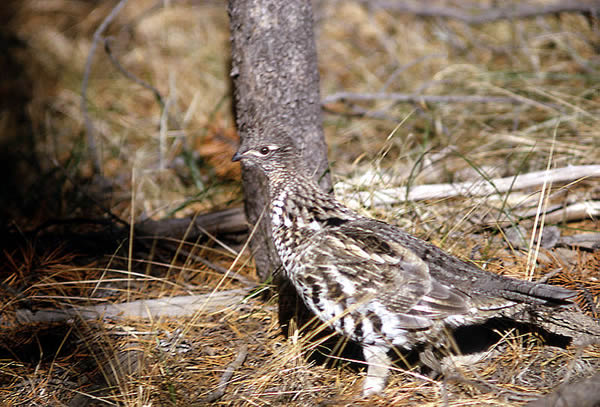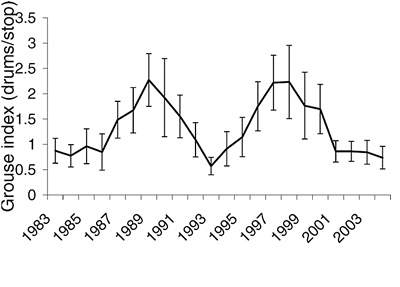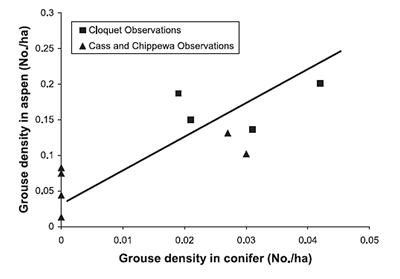Upper Midwest Environmental Sciences Center
Investigations of Ruffed Grouse Habitat Use at Low Population Densities
 The Ruffed Grouse (Bonasa umbelius) is a popular game bird that inhabits northern woodlands across North America. The unique population dynamics of Ruffed Grouse have intrigued scientists for decades. Population densities change dramatically from year to year, with a population peak occurring approximately every 10 years (Figure 1). While scientists are still uncovering what drives this population cycle, some experts believe that habitat availability may play a significant role.
The Ruffed Grouse (Bonasa umbelius) is a popular game bird that inhabits northern woodlands across North America. The unique population dynamics of Ruffed Grouse have intrigued scientists for decades. Population densities change dramatically from year to year, with a population peak occurring approximately every 10 years (Figure 1). While scientists are still uncovering what drives this population cycle, some experts believe that habitat availability may play a significant role.
Historical habitat use
While limited research and data make it easy to generalize habitat selection by any bird – especially for wide-ranging species like the Ruffed Grouse – effective management depends on a detailed understanding of how habitat use relates to population. Historically, Ruffed Grouse have been most highly associated with aspen forest composed of moderately aged trees (10 to 25 years old) that provide ideal habitat for breeding and protection from predators. As a result, Ruffed Grouse management has traditionally focused on aspen forests (1).
Because Ruffed Grouse also occur in other forest types where aspen is absent or minimal – including within the western, eastern and southern extremities of its range – some experts are concerned that an aspen-driven management approach may be too broad and underestimate the importance of other environments. Reports of highly dense Ruffed Grouse populations in coniferous forests (composed of cone-bearing trees, often dominated by evergreens) contradict the theory that these forests are sub-optimal due to increased vulnerability to predators within its thin understory (2).
Linking habitat use with population density
To better understand how habitat use relates to variation in Ruffed Grouse population densities, scientists at the United States Geological Survey (USGS) and the University of Minnesota teamed up to investigate patterns of habitat selection by Ruffed Grouse in central Minnesota. The study was carried out during the declining and low phase of population density – a period during which competition for optimal aspen habitat is low. The research team predicted that Ruffed Grouse would select areas of young aspen forest more often than other forest types.
Methods
The researchers chose study sites in central Minnesota within the Cloquet Forestry Center, Deep Portage Conservation Area and Chippewa National Forest where Ruffed Grouse populations were in the declining phase of the population cycle. Population density was measured by locating drumming males and then statistically related to habitat use within two spatial scales: 1) Landscape scale: To evaluate the importance of multiple habitats, population density was measured within a large landscape scale that encompassed a mix of forest types (aspen, conifer, northern hardwood, mixed forest, wetland, nonforested uplands). Surveys were conducted within landscape areas that ranged from 1.05 to 1.75 km2. 2) Forest-stand scale: Ruffed Grouse densities were also measured within distinct types of forest stands including:
Forest stands were further classified based on the following characteristics:
The forest stands surveyed ranged from 0.12 to 121.51 hectares (average size = 3.36 hectares). |
|
Results
The research team used statistical modeling to relate habitat characteristics to Ruffed Grouse density at both special scales. The data yielded the following results:
- Landscape scale: The density of drumming male grouse was highest in landscapes that contained an even distribution of habitats (i.e. conifer, aspen, hardwood, wetland) and lowest in landscapes with one dominant habitat type. Within these more even landscapes, higher grouse densities were associated with landscapes containing relatively more aspen and fewer conifers.
- Forest-stand scale: Among all the forest stand types surveyed, Ruffed Grouse most often selected young stands of aspen as expected. However, some Ruffed Grouse did select other forest types – including conifer stands – even when aspen stands were unoccupied. This is contrary to what researchers expected to find.
At the forest stand scale, Ruffed Grouse densities were higher within square or round patches of forest with a smaller perimeter distance relative to surface area. Fewer Ruffed Grouse were observed in narrow, elongated stands with longer perimeters and smaller surface areas.
Why might Ruffed Grouse select suboptimal habitat?
Even though young aspen forest is considered optimal habitat, in this study Ruffed Grouse occupied other habitat types when these stands were available. Based on the observations of this study and the existing body of Ruffed Grouse research, the researchers proposed the following explanations for the unexpected results:
- Failure to find optimal habitat: Ruffed Grouse may have been unable to identify aspen habitat and instead settled on less than optimal forest stands (3).
- Reproductive success in other forest types: Successful reproductive efforts in past years within other forest types may influence Ruffed Grouse to select the same site during subsequent years – even if higher quality aspen sites are available (4).
- Lack of food: Ruffed Grouse may choose other forest types if young aspen stands lack nearby food sources including buds and catkins of mature aspens (1).
- Risk of predators: If ground level predators are present within unoccupied aspen stands, Ruffed Grouse may select other forest types. Also, if non-aspen forest stands contain suitable cover from predators (i.e. shrubs within conifer patches), Ruffed Grouse may choose these patches even when aspen habitat is available (5).
The importance of aspen
While Ruffed Grouse surveyed in this study occupied several habitat types, the data indicate that aspen forest can accommodate a higher density of Ruffed Grouse than coniferous forest during the low and declining phases of its population cycle (Figure 2). Furthermore, other research suggests that higher growth rates within aspen forest are linked with a cyclic pattern of high and low population density – a pattern not typically observed within boreal and coniferous forests where growth rates and population densities are lower (6).
Because higher population density within aspen forest is linked with cyclic population dynamics, this study supports that Ruffed Grouse populations in aspen dominated landscapes will have higher population densities and fluctuate more than populations in conifer dominated landscapes.
What this means for management
Even though aspen forest supports the highest grouse density, this study reveals that Ruffed Grouse will still select other forest types – including conifers – even when aspen habitat is available. Researchers are uncertain how this suboptimal habitat use affects population dynamics. Therefore, future research should examine the longterm relationship between habitat use and population density across 10-year population cycles.
Adapted from:
Zimmerman, G. S., R. J. Gutiérrez, W. E. Thogmartin, and S. Banerjee. 2009. Multiscale habitat selection of Ruffed Grouse: predictions for habitat quality at low population densities. Condor 111:294–304.
Cited works:
1. Gullion, G. W., and A. A. Alm. 1983. Forest management and Ruffed Grouse populations in a Minnesota coniferous forest. Journal of Forestry 81:529–536.
2. Gullion, G. W. 1990. Ruffed Grouse use of conifer plantations. Wildlife Society Bulletin 18:183–187.
3. Gray, R. D., and M. Kennedy. 1994. Perceptual constraints on optimal foraging: A reason for departures from an ideal free distribution? Animal Behaviour 47: 469–471.
4. Lanyon, S. M., and C. F. Thompson. 1986. Site fidelity and habitat quality as determinants of settlement patterns in male Painted Buntings. Condor 88:206–210.
5. Zimmerman, G. S., and R. J. Gutiérrez. 2008. Ruffed Grouse Bonasa umbellus habitat selection in a spatially complex forest: evidence for spatial constraints on patch selection. Ibis 150:746–755.
6. Case, T. J. 2000. An illustrated guide to theoretical ecology. Oxford University Press, New York.
7. Zimmerman, G.S., R.J. Guitérrez, W.E. Throgmartin and S. Banerjee. 2009. Multiscale habitat selection by Ruffed Grouse at low population densities. The Condor 111(2):294-304.
8. Zimmerman, G. S., R.R. Horton, D.R. Dessecker and R.J. Gutiérrez. 2008. New insights to old hypotheses: Ruffed Grouse population cycles. Wilson Bulletin 120:239-247.
URL: http://umesc.usgs.gov/terrestrial/ruffed_grouse_habitat.htmlPage Contact Information: Contacting the Upper Midwest Environmental Sciences Center
Page Last Modified: February 1, 2016





